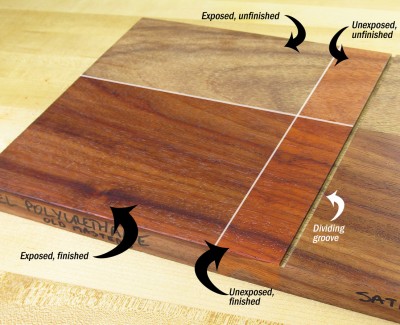The vivid orange color of African padauk wood is, yes, 100% natural. And therefore it has a mind of its own. As a project made with African padauk ages, the orange color of the wood usually turns dark – sort of a maroonish brown – and depending on your taste you’ll either find that objectionable or not. Because this change is largely spurred by ultraviolet light, different wood finishes will preserve padauk’s color to different degrees.
So which wood finish works the best? Which one preserves the color the best? Hard to say – but we’ll hand over the evidence and let you be the judge. We tested 6 different wood finishes on African padauk and set the board outside in direct sun light for 21 days. It’s not a long time, but in direct sun light, the change happens quickly. Here’s what happened:

Here’s how we conducted the finishing test. The board is divided into sections with a shallow groove, then half of each section is finished. The we placed a 2″ wide masking strip across the grain to protect a small control area from light, allowing us to compare apples to apples. How does the wood change with exposure to light? Do different finishes protect the color better?
To make a good comparison I needed four parts for each of the six finishes, which you can clearly see in the picture on the right, above: a raw section, a finished section, and then a smaller section of both the raw and finished that would be protected from the light for control samples.
See the photo at right.
For these control sections I simply placed a 2″ wide strip of masking tape across each of the six sections. In the end, this allows us to compare each of the six exposed finishes to see how it changes and see how each one may protect the color.
Here’s the process:
Is this definitive? No. This is just one test of six finishes – there’s certainly more to be done! But the one lesson to learn here is your project will retain the orange color much longer if you can keep it out of direct light.
See for yourself. Here’s a better look at how each finish behaved in this test. Click the photos to zoom in.
Vice President of Operations – Woodworkers Source
We’re a family-owned lumber & woodworking supply retailer with 3 delightful stores in Arizona, and 35 friendly employees.
Mark oversees the company and creates tutorials on wood finishing and woodworking tips for hardwood lumber.
Woodworkers Source is a division of MacBeath Hardwood Co.
